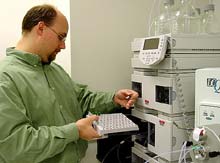Articles and reports from the Life Sciences and chemistry area deal with applied and basic research into modern biology, chemistry and human medicine.
Valuable information can be found on a range of life sciences fields including bacteriology, biochemistry, bionics, bioinformatics, biophysics, biotechnology, genetics, geobotany, human biology, marine biology, microbiology, molecular biology, cellular biology, zoology, bioinorganic chemistry, microchemistry and environmental chemistry.

While promising the possibility of hardier crops and a larger, more robust food supply for the world, worries continue over the effect genetically engineered plants might have on the environment. One fear is over the movement of altered genes from domesticated populations to the wild and the effect of these “escaped” genes on ecosystems. In a study published in the December issue of Ecological Applications, Charity Cummings (University of Kansas), Helen Alexander (University of Kansas), Allison Snow

Research continues in an effort to determine if these neural cells can be transplanted to treat stroke, brain tumors and neurodegenerative disorders
Researchers at Cedars-Sinai’s Maxine Dunitz Neurosurgical Institute have for the first time demonstrated that stem cells from whole adult bone marrow can be differentiated into several types of cells of the central nervous system.
A long-term objective of this research is to determine if these neural stem cells can be trans

Scientists are still learning what’s in a drop of ocean water, according to this week’s Nature Magazine. And the answers have implications for the whole planet, says co-author Craig Carlson, an oceanographer at the University of California, Santa Barbara. Carlson is an assistant professor in the Department of Ecology, Evolution and Marine Biology.
About ten thousand bacterioplankton of the type SAR 11 are found in every drop of seawater. And yet, as explained in the article, which

Last April Swedish scientists discovered high levels of a potentially cancer-causing chemical called acrylamide in wide range of starch-containing foods that are fried or baked, particularly french fries, potato chips and crackers. The announcement received worldwide publicity. But at the time, no one knew where the acrylamide came from, how it was formed, or, indeed, if there is a link between acrylamide in food and cancer. The findings were quickly confirmed by the British Food Standards Agency. Ea

A broad group of discoveries about the biological powers of “small-RNA” molecules, some of which were made by researchers at Oregon State University, will be hailed on Friday as the scientific “Breakthrough of the Year” by the journal Science. Science is published by the American Association for the Advancement of Science, the world’s largest general scientific society, and each year the prestigious journal identifies what it believes were the top 10 research advances of the year.
For 2

In a significant scientific advance, researchers at the Department of Energy’s Pacific Northwest National Laboratory have identified or confirmed 490 proteins in human blood serum — nearly doubling the number of known serum proteins, according to a paper accepted for publication in the December issue of Molecular and Cellular Proteomics.
“We have performed the most extensive identification of proteins in serum to date,” said Joel Pounds, corresponding author and a PNNL staff scientist. “We s